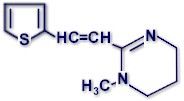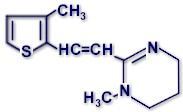Tetrahydropyrimidines are a chemical class  of antiparasitic compounds moderately used on pets, horses and livestock to control parasitic worms. Tetrahydropyrimidines were introduced in the 1960's. They are used mainly as veterinary anthelmintics. Pyrantel is also approved for use on humans. They are not used in agriculture.
of antiparasitic compounds moderately used on pets, horses and livestock to control parasitic worms. Tetrahydropyrimidines were introduced in the 1960's. They are used mainly as veterinary anthelmintics. Pyrantel is also approved for use on humans. They are not used in agriculture.
Tetrahydropyrimidines are veteran anthelmintics, i.e., they have lost patent protection long ago and are available as generics manufactured by numerous chemical companies (typically in China, India, Israel, Brazil, etc.).
Click here for a general introduction to parasiticides and their most important features.
Active ingredients and parasites controlled
The most important tetrahydropyrimidines for veterinary use are:
- Morantel: narrow spectrum nematicide. Scarcely used in livestock and pets. Moderately used in horses.
- Oxantel: narrow spectrum nematicide. Moderately used in pets, very seldom in livestock.
- Pyrantel: narrow spectrum nematicide. Used a lot in dogs, cats and horses. Very scarcely used in livestock.
Tetrahydropyrimidines are endoparasiticides with a narrow spectrum of activity against gastrointestinal roundworms (nematodes), mainly against ascarids (e.g. Toxocara canis, Toxocara cati, Toxascaris leonina, Parascaris equorum, etc), i.e. they are nematicides. Oxantel is particularly effective against whipworms (e.g. Trichuris spp).
They have no efficacy against non-gastrointestinal roundworms (e.g. lungworms, eyeworms, etc.), tapeworms (cestodes) or flukes (trematodes). Efficacy against larval stages is usually insufficient.
Tetrahydropyrimidines were initially popular for use on livestock. Nowadays they have been largely replaced by more modern anthelmintics with a larger spectrum of activity.
Delivery forms of tetrahydropyrimidines
For dogs and cats tetryhydropyrimidines are available mostly in solid forms such as tablets, pills, etc. or as liquid drenches or pastes. Mixtures with other active ingredients to broaden the spectrum of activity are very common. A typical mixture is pyrantel + praziquantel, a taenicide that controls tapeworms.
For horses they are used mainly in horse-specific oral pastes or gels.
For livestock there are still some slow-release boluses available in a few countries.
Tetrahydropyrimidines are not available as injectables or spot-ons.
Unless delivered using a slow-release device, tetrahydropyrimidines have no residual effect. This means that a single administration will kill the parasites in the host, but will not protect against re-infestations.
Mechanism of action of tetrahydropyrimidines

Tetrahydropyrimidines act on the nervous system of the worms as inhibitors of acetylcholinesterase (also known as AchE), an enzyme that hydrolyzes acetylcholine (Ach). Ach is a molecule involved in the transmission of nervous signals from nerves to muscles (so-called neuromuscular junctions) and between neurons in the brain (so-called cholinergic brain synapses).
AchE's role is to terminate the transmission of nervous signals where acetylcholine is the neurotransmitter (there are several other neurotransmitters). Inhibition of AchE massively disturbs the normal movements of the parasites. The bottom line for the parasites is that they are paralyzed and die more or less quickly or are expelled from the gut because they cannot keep themselves attached to the intestinal wall.
Pharmacokinetics of tetrahydropyrimidines
After oral administration, tetrahydropyrimidines are poorly absorbed to blood. Highest blood concentrations are reached 2 to 3 hours after administration. Absorption is higher in dogs, cats and horses than in ruminants (cattle, sheep, goats).
Once absorbed, the active ingredients are quickly metabolized and excreted through urine. In ruminants a large amount of the administered dose is excreted unchanged through the feces.
Oxantel is less absorbed than pyrantel or morantel and it reaches higher concentrations in the large intestine, the preferential site of whipworms (Trichuris spp). This is why it is especially effective against such worms.
Safety of tetrahydropyrimidines
Products with tetrahydropyrimidines are usually well tolerated by pets and livestock, with safety margins of 5 or higher.
Due to its poor absorption to blood and its fast metabolism morantel tartrate does not build detectable residues in milk and is approved for use on dairy livestock in several countries.
Additional specific information (toxicity, intoxication symptoms, adverse drug reactions, antidote, etc.) on the safety for veterinary use of the most used tetrahydropyrimidines is available in specific articles in this site:
General information on the safety of veterinary antiparasitics is available in specific articles in this site (click to visit):
- General safety of antiparasitics for domestic animals
- General safety of antiparasitics for humans
- General safety of antiparasitics for the environment
|
WARNING Never use livestock, horse or poultry products on dogs and/or cats, unless explicitly approved for dogs and/or cats too. Without reliable use instructions they can be easily overdosed, and pets may not tolerate formulations developed for use on livestock, horses and/or poultry. Some active ingredients may be toxic to particular animals. It is obvious that veterinary medicines are not intended for and should never be used on humans!!! |
Resistance of worms to tetrahydropyrimidines
There are reports on resistance of various gastrointestinal roundworms (mainly Haemonchus spp, Ostertagia spp and Trichostrongylus spp) to morantel in sheep, goats, cattle and pig in a few countries, and to pyrantel in swine (Oesophagostomum spp). However, the problem does not seem to be as serious as for benzimidazoles, levamisole or macrocyclic lactones.
There are also reports on resistance of Ancylostoma spp to pyrantel in dogs, and of cyathostomins in horses, apparently with cross-resistance to levamisole.
Visit also the section in this site about parasite resistance to antiparasitics and more specifically to pyrantel.